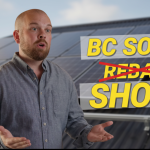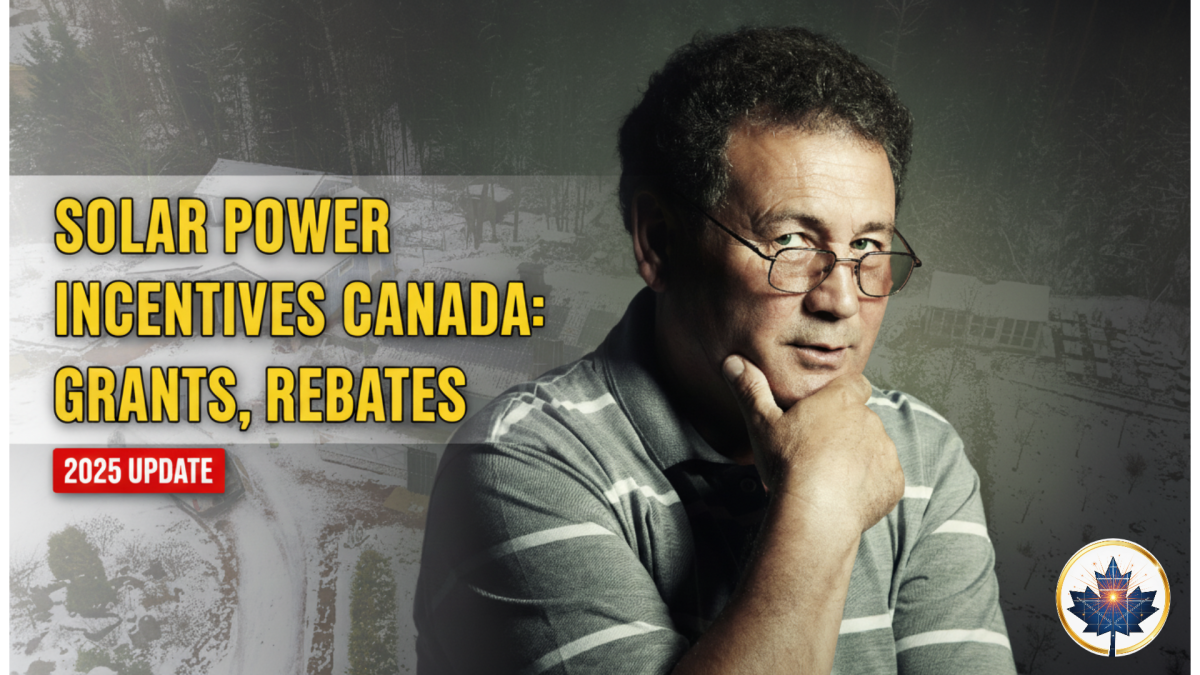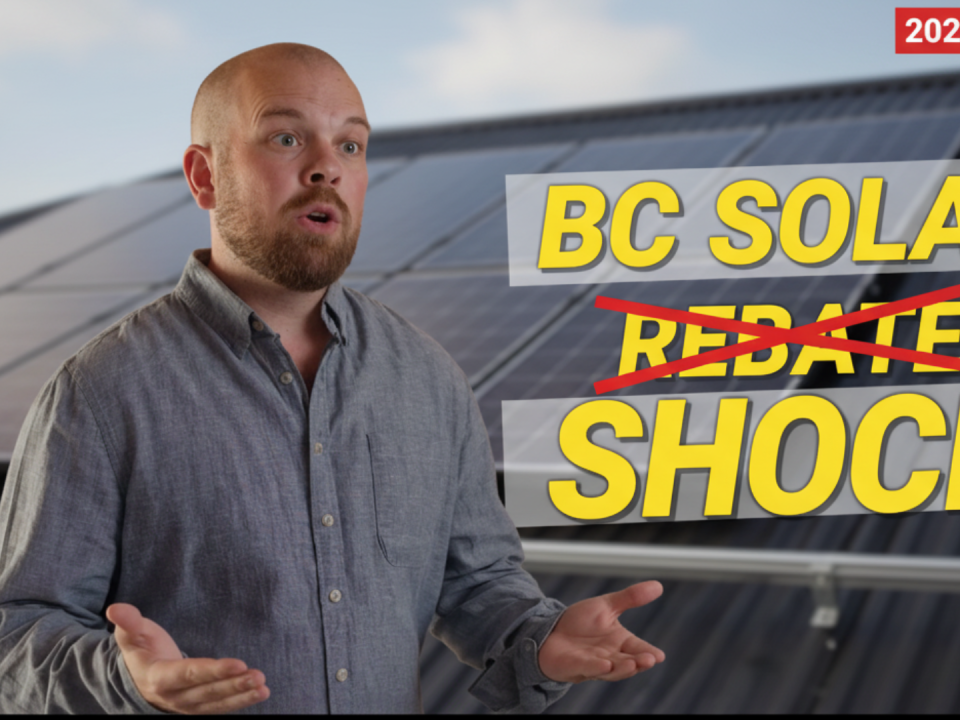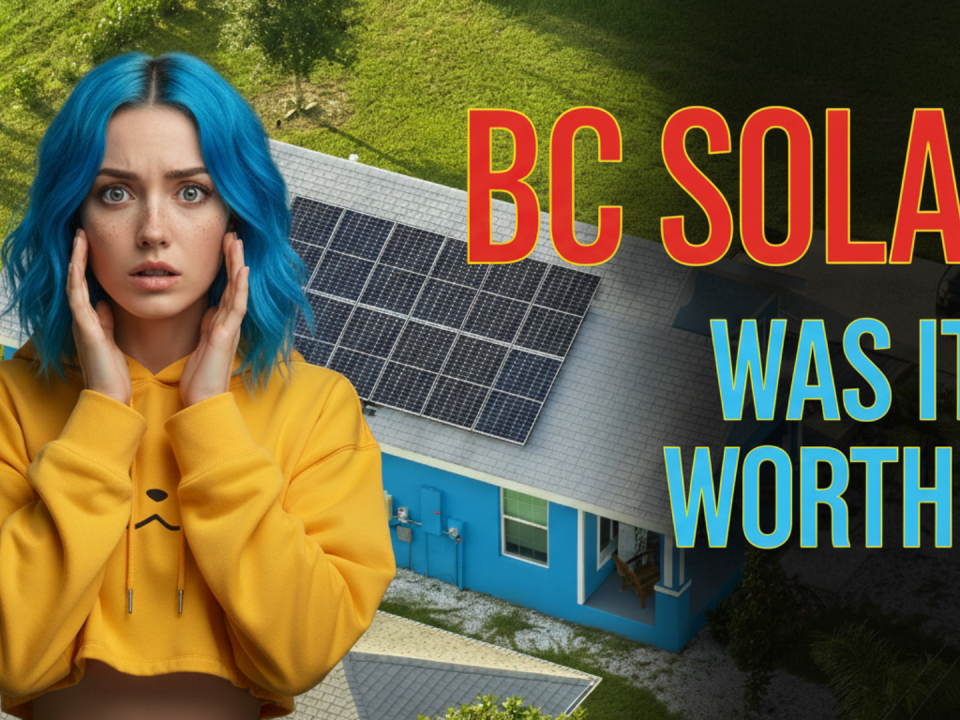
Do solar panels increase home value in Canada
October 15, 2025
Solar Panel Rebates BC For Rooftops And Battery Storage Updated 2025
October 22, 2025Let’s get straight to it. The world of solar incentives in Canada has been turned upside down. You’ve probably heard about the big federal programs ending, and it’s caused a lot of confusion. Many people are asking me if going solar is still worth it without those grants. The short answer is yes, but the way you get there has changed. The money is still out there, but now it’s hiding in different places. There are still many reasons to install solar panels in Canada.
This guide is my breakdown of every single solar grant, rebate, and loan that is actually working in Canada for 2025. I’ll also cover the popular ones that have already closed so you know what’s off the table. We’re going to look at the data, the real numbers, and what it all means for your wallet.
A Quick Summary of Provincial Rebates (2025)
| Province / Territory | Key Incentives & Rebates | Net Metering Policy | Important Notes & Status |
|---|---|---|---|
| British Columbia | • Up to $5,000 for Solar PV ($1,000/kW) • Up to $5,000** for Battery Storage • 7% PST Exemption on equipment. | Credits at full retail rate. Surplus paid out annually on March 1st at market rate (~9.99¢/kWh). | Rebate is for BC Hydro customers only; FortisBC customers are not eligible. |
| Alberta | • No provincial rebate. • Municipal Rebates: – Banff: **$750/kW – Medicine Hat: $200/kW (up to $1,000) | Deregulated market allows for “Solar Club” programs to sell excess power at premium rates. | Edmonton’s program is closed. The Clean Energy Improvement Program (CEIP) offers property-assessed loans with a 10% up-front rebate. |
| Saskatchewan | • Grant for farms installing solar/wind water pumps. | Surplus energy credited at 7.5 cents/kWh. Credits never expire. | Support is modest compared to other provinces. |
| Manitoba | • Homeowners: $0.50/watt (up to $5,000) • Businesses: **$0.75/watt** | Not traditional net metering. Surplus is sold to the grid at a very low rate (~2.4¢/kWh). | It’s best to size systems to match usage, not to export power. Manitoba Hydro offers a financing loan. |
| Ontario | • Up to $5,000 for Solar Panels • Up to $5,000 for Battery Storage | 1-to-1 kWh credits for energy sent to the grid. | Credits expire after 12 months with no cash payout. Low-interest PACE-style loans are available in Toronto and Ottawa. |
| Quebec | • No specific rebate for solar panels. | Credits for surplus energy expire after 24 months. | Support is available for other energy retrofits (insulation, heating) but not directly for solar PV. |
| New Brunswick | • $0.20/watt (up to $3,000) | Banked energy credits are reset to zero on March 31st each year. | A pre-retrofit EnerGuide evaluation is required before installation to qualify for the rebate. |
| Nova Scotia | • SolarHomes program is CLOSED. • Pilot for Non-Profits: **$0.60/watt** (up to $15,000) | N/A (policy depends on utility) | Focus has shifted to pilot programs for batteries and non-profits. PACE financing is available in some areas. |
| Prince Edward Island | • **$1.00/watt** (up to $10,000) | 1-to-1 crediting. | PAUSED. The program is not currently accepting applications but is expected to return in April 2026. |
| Newfoundland & Labrador | • No residential rebates. • 20% green tech tax credit for corporations. | N/A (policy depends on utility) | Very limited support for homeowners. |
| Yukon | • **$800/kW** ($0.80/watt), up to $5,000. | N/A | PAUSED. The Micro-generation Program is paused, preventing new grid connections for most projects. |
| Northwest Territories | • Covers 50% of project costs. – Residents: up to **$20,000** – Businesses: up to $50,000 | N/A (policy depends on utility) | A very generous program run by the Arctic Energy Alliance (AEA). |
| Nunavut | • Covers 50% of project costs, up to $30,000. | 1-to-1 net metering at the full retail rate of nearly 75 cents/kWh. | One of the best programs in Canada due to high electricity costs. |
The Big Picture: What Happened to Federal Solar Incentives?
The federal government has split its strategy. For businesses, the support is strong and clear. For homeowners, it’s a completely different story. The universal programs that helped thousands of Canadians are gone, replaced by something far more specific.
Solar Incentives For Businesses: It’s Still a Good Deal
If you own a business, farm, or commercial property, the federal government is still offering powerful incentives to help you install solar. These are designed to make large-scale projects financially smart, especially for those considering solar panels on farmland.
This is a refundable tax credit that gives you back 30% of the capital cost for a new solar PV system, battery storage, or other clean technologies. It’s a direct way to slash the price tag of your project. This program is set to run until 2034, which gives businesses the stability needed to plan major investments.
On top of that, there’s the Accelerated Capital Cost Allowance (CCA). This lets your business write off the cost of your solar equipment much faster than normal assets. For solar systems, you can deduct a huge portion of the system’s cost from your taxable income in the very first year. Some sources say the 100% first-year write-off has been extended to 2025, while others point to a phasedown to 75% in 2025. Either way, it provides a big, immediate boost to your project’s cash flow.
Solar Incentives For Homeowners: A Major Shift
Here’s where things get complicated for most people. The programs you’ve heard about for years are no longer available for new applicants.
- The Canada Greener Homes Grant is GONE. This was the program that offered up to $5,000 to help with the cost of solar panels and other retrofits. It was incredibly popular—so popular, in fact, that it burned through its entire budget years ahead of schedule. With over 500,000 applications, the funds were fully committed, and the government shut it down for new applicants in February 2024. You can read my full breakdown of the Canada Greener Homes Grant closure.
- The Canada Greener Homes Loan is ALSO GONE. This was the other half of the federal plan, offering up to $40,000 as an interest-free loan with a 10-year repayment term. It was a game-changer for making large projects affordable. Like the grant, it was a victim of its own success and closed to new applications on October 1, 2025. I’ve written about what to do now that the Greener Homes Loan and Grant are gone.
In their place, the government has introduced the Canada Greener Homes Affordability Program. But this is not a replacement. It’s a completely different program targeted only at low-to-median-income households. It’s a “direct-install” model, meaning an organization handles the retrofits for you at no cost.
Here’s the problem: official announcements talk about insulation and heat pumps, but there has been no clear confirmation that solar panels are even included. This new, targeted approach has created what I call the “middle-income gap.” If you don’t qualify for low-income support but still can’t afford a $30,000 project out of pocket, there is no longer a dedicated federal program to help you.
Province-by-Province Incentives Breakdown in 2025
With the federal changes, the most important incentives are now at the provincial, territorial, and even municipal levels. Where you live is now the single biggest factor in how much you can save.
British Columbia
BC is a leader right now. The main program is the(Rebates for solar panels and battery storage in BC). For a deeper look, check out my(Solar Panels BC Guide).
- Rebate: You can get up to $5,000 for a solar PV system ($1,000 per kW installed) and a separate, stackable rebate of up to $5,000 for a battery storage system ($500 per kWh of capacity).
Important details: The solar rebate is capped at 50% of your project cost. Also, you must go through BC Hydro’s interconnection process (their Net Metering program) and get pre-approval as part of the rebate application.
- Tax Exemption: On top of the rebate, all qualifying renewable energy equipment is exempt from the 7% Provincial Sales Tax (PST). This is a nice extra saving.
- Net Metering:(BC Self Generation) credits you for excess power. Once a year, on March 1st, they pay you out for any surplus credits at the market rate.
All major BC utilities (BC Hydro, FortisBC, and municipal utilities like in Nelson or Penticton) offer net metering. With net metering, any surplus power your panels produce goes back to the grid and you get credited. BC Hydro’s program credits you at full retail rate for excess electricity, and if you have a credit remaining at your annual anniversary date, they’ll cut you a cheque at about 9.99 cents/kWh. In practice, you’d size your system so you use most of your solar energy, but it’s good to know you can get paid for extra.
What if you’re not in BC Hydro’s electric service area? BC has a second utility, FortisBC in part of Kelowna, serving some communities. As of 2025, FortisBC does not offer an equivalent solar rebate for its customers. The BC Hydro program was funded by the province for BC Hydro only (as of its launch). FortisBC customers can still do net metering, but no provincial rebate is in place for them yet. (However, FortisBC does collaborate on other programs like EV charger rebates, so solar might follow – stay tuned in coming years.)
Solar Incentives In Alberta
Alberta doesn’t have a province-wide rebate, but it has some of the best municipal programs and a fantastic financing option. You can find more details in my guide to solar panels in Alberta.
- Municipal Rebates:
Edmonton: The(Edmonton solar rebate program is closed) offers $0.50 per watt for multi-unit residential buildings, up to $4,000 per dwelling. Learn more about thecost of solar panels in Edmonton.- Banff: The(Banff Solar Production Incentive Program) gives a rebate of $750 per kW for homes and businesses.
- Medicine Hat: The(Medicine Hat Rebate Program) offers $200 per kW, up to $1,000.
- Financing: The Clean Energy Improvement Program (CEIP) is Solar Financing. It’s a Property Assessed Clean Energy (PACE) loan, which means you finance your project with competitive rates and repay it through your property tax bill over a long term (up to 25 years). The loan is tied to the property, not you, so it transfers if you sell your home and it even provides a 10% up-front rebate on project costs for participants as an incentive. That means if you install a $30,000 solar system through CEIP, Calgary might forgive $3,000 of the cost, and you finance the rest via property tax payments. Edmonton’s CEIP started earlier and has helped homeowners do solar without big upfront cash – you pay it off over 20 years on your taxes, offset by energy savings.
The City of Calgary offers an interest rate of 3.75% for pre-qualification submissions received in 2025.
- Market Programs: Alberta’s deregulated market allows for programs like the Solar Club, where you can sell your excess power back to the grid at a premium rate. For instance, one popular Solar Club plan pays about 0.28 $/kWh for solar exports in summer but charges ~0.14 $/kWh for usage in winter – the idea is to credit you generously for summer surplus. It’s a way to maximize the value of your solar production in sunny months. However, be cautious: if you join, you must manually switch rates seasonally (and the rates can change).
Saskatchewan
Saskatchewan’s support is more modest. The main incentive is the(Net Metering in Saskathewan). Read my complete(solar panel saskatchewan guide) for more information.
- Net Metering: You get a credit of 7.5 cents per kWh for surplus energy sent to the grid. A key benefit here is that the credits never expire as long as your account is active, so you can bank summer credits for winter use.
- Other Incentives: There is a grant for farms installing solar or wind-powered water pumps.
Manitoba
Manitoba has a straightforward rebate program run by Efficiency Manitoba. For all the details, see my Manitoba solar panels guide.
- Rebate: Homeowners can get $0.50 per DC watt installed, up to a maximum of $5,000 from the(https://efficiencymb.ca/solar/). Businesses get an even better rate of $0.75 per watt.
- Financing: Manitoba Hydro offers a Home Energy Efficiency Loan of up to $20,000 for solar with a 15-year term. The interest rate is currently 6.20% for the first five years.
- Generation Policy: Manitoba doesn’t have traditional net metering. Any surplus power is sold to the grid at a very low rate (around 2.4¢/kWh), so it makes sense to size your system to match your usage, not to export power.
Ontario
Ontario’s incentive landscape is a patchwork of different programs from municipalities and local utilities. My guide to solar panels in Ontario breaks it all down.
- Utility Rebates: The(Home Renovation Savings Program) from Save On Energy and Enbridge Gas offers up to $5,000 for solar panels and another $5,000 for battery storage.
- Municipal Loans: Major cities offer PACE-style loans. Toronto’s Home Energy Loan Program (HELP) and Ottawa’s(Better Homes Ottawa) both offer low-interest loans up to $125,000, repaid on your property tax bill.
- Net Metering: All Ontario utilities offer net metering for solar installations. For each kWh you send to the grid, you get a kWh credit to use later. Credits roll over and can be carried for up to 12 months. If you have credits left after 12 months, they reset to zero (no cash payout). So like other provinces, you want to size your solar to cover your annual usage but not grossly overproduce.
Quebec
Quebec doesn’t offer a specific rebate for solar panels. Instead, support is built into Hydro-Québec’s broader energy efficiency programs. See my Quebec solar panels guide for a full overview.
- Net Metering: The main support is Hydro-Québec’s net metering program, which gives you credits for surplus energy you send to the grid.
Hydro-Québec’s policy is that credits expire after 24 months (so you have two years to use any banked surplus, which is fairly generous – many provinces only allow one year). There is a size limit of 100 kW for residential net metering, which is more than enough for any home
- Related Programs: Quebec’s RenoClimat and Chauffez Vert programs provide grants for home energy retrofits – primarily insulation, windows, and heating system upgrades. For instance, Chauffez Vert will give up to about $5,000 for removing an oil furnace and installing electric heating. These do not cover solar installations. So if you’re looking through Quebec’s energy programs, you won’t find solar PV incentives listed. (They do mention solar air or thermal in some contexts, but not PV.)
New Brunswick
New Brunswick’s support comes from a single program run by SaveEnergyNB. You can find all the specifics in my(https://solarenergies.ca/solar-panels-new-brunswick-canada-guide/).
- Rebate: The(home energy savings program in NB) offers a rebate of $0.20 per watt ($200/kW), up to a maximum of $3,000.
- Tip for New Brunswick Homeowners: You must register with the program and have a pre-retrofit EnerGuide home evaluation done before you install anything. I’ve seen people lose out on the rebate because they did the work first. Don’t make that mistake.
- Net Metering: A critical detail here is that all your banked energy credits are reset to zero on March 31st each year. This means you need to size your system carefully to match your annual usage, or you’ll lose the value of your extra production.
Nova Scotia
After the popular SolarHomes program closed, Nova Scotia’s incentives have become more targeted. I cover the current situation in my(Solar panels nova scotia guide).
- SolarHomes Program: This program, which offered $0.30/watt up to $3,000, is closed to new applications as of April 17, 2025, because its funding ran out.
- Current Programs:(https://www.efficiencyns.ca/) is now running pilot programs for Home Battery installations and Solar for Non-Profits. Efficiency Nova Scotia offers a rebate of $0.60 per watt (DC), covering 25 % of system costs before HST, up to $15,000 for grid-tied solar PV systems installed by registered non-profits and charities.
- EnergyForward New Homes: New single-family homes that enroll in this program can count solar generation toward incentive calculations when the system is designed and installed by an Efficiency NS Registered Solar Installer. (Homes that take this incentive cannot also claim a SolarHomes rebate.)
- Financing: The PACE Atlantic SwitchPACE Program is available in some areas, offering property-based financing up to $40,000.
Prince Edward Island
PEI has one of the most generous rebates in Canada, but it’s also one of the most unstable. I’ve written about the PEI solar rebate program closure and have a full guide to solar in PEI.
- Rebate: The Solar Electric Rebate Program offered an incredible $1.00 per watt for homeowners, up to $10,000.
- Current Status: The program is currently PAUSED and not accepting new applications. It was so popular that it ran out of money for the fiscal year. This has happened twice in the last year, which creates a lot of uncertainty for homeowners and installers. The government says it plans to continue the program in the next fiscal year starting April 2026. Islanders can check for other programs at PEINetZero.ca.
- Net Metering in PEI: Maritime Electric (the main utility) and Summerside Electric (municipal utility for that city) both offer net metering. PEI’s net metering is 1:1 crediting. Surplus credits at year-end can be carried over or paid out at the utility’s discretion.
Newfoundland and Labrador
There are currently no province-wide rebates for residential solar in Newfoundland and Labrador. The main support is a 20%(green technology tax credit) for corporations. For more information, see my Newfoundland and Labrador solar guide.
The Territories
In the north, incentives are designed to combat the extremely high cost of diesel-generated electricity.
- Yukon: The Good Energy Program offers a rebate of $800 per kW ($0.80/watt), up to a maximum of $5,000. However, there is a huge roadblock: the Micro-generation Program is paused for anyone connected to the main Yukon grid. This means you can’t connect a new solar system to the grid, which stops most projects before they start. Read my(solar panels yukon guide/) for more.
- Northwest Territories: The Arctic Energy Alliance (AEA) provides rebates covering 50% of project costs, up to $20,000 for residents and $50,000 for businesses. My(solar panels northwest territories guide) has all the details.
- Nunavut: Given its high electricity costs, Nunavut has one of the best programs. The(homeownership) covers 50% of total project costs, up to a massive $30,000. This is paired with a 1-to-1 net metering program, where every kWh you export is worth the full retail rate of nearly 75 cents. Learn more in my Nunavut solar panels guide.
The Incentive Graveyard: Why Good Programs Disappear
It’s frustrating to see great programs end. It creates a “boom-bust” cycle that is tough on the industry and confusing for homeowners. Understanding why they close helps explain the current situation.
The Canada Greener Homes Grant: A Victim of Success
The Greener Homes Grant was the federal government’s main tool for residential solar from 2021 to 2024. It offered up to $5,000 for retrofits and $600 for the required energy audits. The problem was simple: it was too successful. The government budgeted $2.6 billion to last until 2027, but Canadians were so eager to make upgrades that the money was all spoken for in under three years.
The sudden closure was disruptive. Solar companies and energy advisors had hired staff and scaled up to meet demand. When the program ended, it led to cancelled projects and job losses, with an estimated 600 energy advisor positions cut. It’s a classic example of how stop-and-start funding can hurt an industry more than it helps.
Provincial Problems: Nova Scotia and PEI
The same story has played out at the provincial level. Nova Scotia’s SolarHomes program was a key driver of solar adoption but closed when its funds were depleted. You can read about the(past present and future of solar energy in nova scotia) on my blog. PEI’s incredibly generous Solar Electric Rebate Program has been paused twice in a single year because demand keeps exceeding its annual budget. This pattern of instability makes it hard for people to plan.
My Advice: How to Make Solar Work for You in 2025
The landscape is more complicated, but you can still make a smart investment. Here’s my advice.
Look Local First
Your first step should be to investigate your provincial, territorial, and municipal programs. This is where the most significant direct funding for homeowners is now located. A homeowner in BC or an eligible resident in Nunavut can still get tens of thousands of dollars in support.
Understand Your Net Metering Rules
Net metering is how you get value for the extra electricity your panels produce, but the rules vary wildly. This determines if you can sell electricity back to the grid in Canada.
- In places like New Brunswick and Nunavut, your credits reset to zero every March 31st. This means you want a system that produces close to what you use annually, but not much more.
- In Alberta, the Solar Club lets you sell power at a very high rate in the summer, which can be profitable.
- In Saskatchewan, your credits never expire, which is a great perk. These rules directly affect your return on investment, so make sure you understand them.
Smart Financing is Key
With the federal interest-free loan gone, financing is more important than ever. I’ve written a guide on how to finance your solar panels now.
- PACE Loans: If you live in an area with a PACE program (like the CEIP in Alberta or municipal programs in Toronto and Ottawa), this is your best option. The loan is tied to your property, the rates are competitive, and the terms are long.
- Installer Financing: To help fill the void left by the federal loan, we’ve partnered with companies like Polaron, which can offer financing options like 0% interest over 15 years with zero down payment. This makes the upfront cost manageable without relying on a government program and is often the best deal available.
- Other Options: Many installers offer financing through partners like Financeit. Local credit unions also offer “green loans”. These are good for access, but you need to watch the interest rates. A higher rate will extend your payback period and affect whether the solar panels pay for themselves.
I had a client recently in Edmonton who was really disappointed to learn the federal grant was gone. He was ready to give up on his project. But we sat down and looked at what was available locally. He was able to use the CEIP program for financing, which meant no large upfront cost. On top of that, his business was eligible for the 30% federal CTITC tax credit. In the end, his project was even more affordable than he had originally planned. It just took a bit more digging.
Final Thoughts
The way to get help paying for solar in Canada has changed. The easy, one-size-fits-all federal programs are gone for most homeowners. The system is now a patchwork of provincial and local incentives. Homeowners must now navigate this complex landscape to find the best options available to them. This shift means that understanding canada’s solar rebate implications is more crucial than ever for those looking to invest in solar energy. As each province offers different schemes, diligent research is necessary to maximize potential savings and benefits.
It requires more homework from you. You need to check what your province offers, what your city offers, and what your utility’s rules are. But as you can see from this guide, there are still amazing programs out there. From huge grants in the territories to strong rebates in BC and innovative financing in Alberta, the support exists.
Don’t let the headlines about program closures discourage you. The path to solar is just different now. With the right information, you can still make a great investment that will lower your bills, increase your home’s value, and give you control over your energy future. For more insights, you can always visit my blog.




